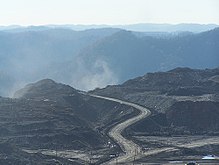
Back أثر صناعة الفحم على البيئة Arabic Contaminació industrial del carbó Catalan Ahụike na mmetụta gburugburu ebe obibi nke ụlọ ọrụ coal IG കൽക്കരി വ്യവസായത്തിന്റെ പരിസ്ഥിതി ആഘാതം Malayalam Impacto ambiental da indústria do carvão Portuguese Влияние угля на здоровье и окружающую среду Russian 煤炭產業對健康與環境的影響 Chinese


| Part of a series on |
| Coal |
|---|
 |
The health and environmental impact of the coal industry includes issues such as land use, waste management, water and air pollution, caused by the coal mining, processing and the use of its products. In addition to atmospheric pollution, coal burning produces hundreds of millions of tons of solid waste products annually, including fly ash,[1] bottom ash, and flue-gas desulfurization sludge, that contain mercury, uranium, thorium, arsenic, and other heavy metals. Coal is the largest contributor to the human-made increase of carbon dioxide in Earth's atmosphere.
There are severe health effects caused by burning coal.[2][3][4] Worldwide 25 people die early for each terawatt hour of electricity generated by coal, around a thousand times more than nuclear or solar.[5]
In addition, there have been many coal mining disasters, although work related coal deaths has declined substantially as safety measures have been enacted and underground mining has given up market share to surface mining.[citation needed] Underground mining hazards include suffocation, gas poisoning, roof collapse and gas explosions. Open cut hazards are principally mine wall failures and vehicle collisions.[6] Hundreds of people died in coal mine accidents in 2022.[7]
- ^ RadTown USA | US EPA
- ^ Toxic Air: The Case for Cleaning Up Coal-fired Power Plants (PDF) (Report). American Lung Association. March 2011. Archived from the original (PDF) on 15 May 2012. Retrieved 9 March 2012.
- ^ "Environmental impacts of coal power: air pollution". Union of Concerned Scientists. Archived from the original on 11 November 2005. Retrieved 9 March 2012.
- ^ Henneman, Lucas; Choirat, Christine; Dedoussi, Irene; Dominici, Francesca; Roberts, Jessica; Zigler, Corwin (24 November 2023). "Mortality risk from United States coal electricity generation". Science. 382 (6673): 941–946. Bibcode:2023Sci...382..941H. doi:10.1126/science.adf4915. ISSN 0036-8075. PMC 10870829. PMID 37995235.
- ^ Ritchie, Hannah; Roser, Max (28 December 2023). "What are the safest and cleanest sources of energy?". Our World in Data.
- ^ "Coal Fatalities for 1900 Through 2016". Arlington, VA: U.S. Mine Safety and Health Administration (MSHA). Archived from the original on 3 October 2015. Retrieved 25 October 2017.
- ^ "China shifts approach to fatal coal mining accidents to ensure supply security". MINING.COM. Retrieved 25 January 2024.